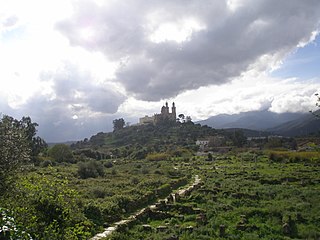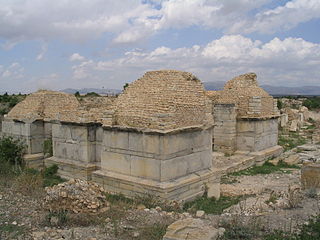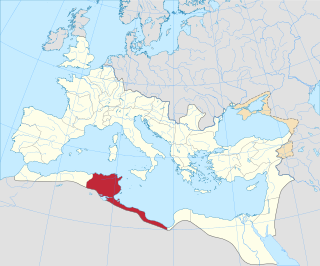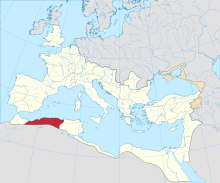
Hippo Regius is the ancient name of the modern city of Annaba, in Algeria. Hippo Regius was a Phoenician, Berber, and Roman city in present-day Annaba Province, Algeria. It was the locus of several early Christian councils and home to the philosopher and theologian Augustine of Hippo.

Parthenia was a Roman–Berber town in the former Roman province of Mauretania Sitifensis, the easternmost part of ancient Mauretania. It was located in what is now northern Algeria.

Djelfa (Arabic: الجلفة, translit. al-Ǧilfah is the capital city of Djelfa Province, Algeria and the site of ancient city and former bishopric Fallaba, which remains a Latin catholic titular see.

Segermes is an ancient town in Tunisia. Under the Roman Empire, the city belonged to the province of Byzacena. The town is identified with ruins at Henchir Harat, Zaghouan( 36° 20′ 43″ N, 10° 18′ 03″ E).
Nigizubi was a Roman–Berber town in the province of Numidia. It was located in modern Algeria. It was also the seat of an ancient bishopric.during the Vandal Kingdom and Roman Empire. The exact location of the ancient town is now lost but it was somewhere in north-eastern Algeria.

Pocofeltus was a Roman–Berber civitas (town) in the province of Africa Proconsularis, located in present-day Tunisia. It was also the seat of an ancient Roman Catholic diocese.
Canapium was a Roman-Berber town in the province of Africa Proconsolare. Its stone ruins are located near Henchir-El-Casbath, in the region of Mornag, Tunisia.

Culusi was a Roman town of the Roman province of Africa Proconsolare, located near Carthage. It is also known as Culcitana or Culsitana. The city is tentatively identified with ruins in the suburbs of Tunisia.

Muzuca was a Roman Town of the Roman province of Byzacena during late antiquity. The town has tentatively been identified with the ruins at Henchir-Besra in modern Tunisia. Very little is known of the city, though in situ epigraphical evidence gives us the name and that in late antiquity it achieved the status of Municipium.

Scebatiana was an ancient civitas of the Roman Province of Byzacena during the Roman Empire and late antiquity. The exact location of the town is unknown, but is thought to be somewhere in southern Tunisia.

Gunugus or Gunugu was a Berber and Carthaginian town in northwest Africa in antiquity. It passed into Roman control during the Punic Wars and was the site of a colony of veteran soldiers. It survived the Vandals and Byzantines but was destroyed during the Muslim invasion of the area.
Reperi was an ancient Roman town of Roman North Africa, in the Roman province of Mauretania Caesariensis. The exact location of the ancient town is now unknown, but is surmised to have been in northern Algeria. The town seems to have lasted until the Muslim conquest of the Maghreb.

Grimidi was an ancient Roman town of the Roman province of Mauretania Caesariensis, located at 3.73031 35.87687 in North Africa. It flourished from about 30BC to about 640AD. Numerous ruins litter the site.

Sereddeli was an ancient Roman town of the Roman province of Mauretania Caesariensis, in North Africa. Sereddeli flourished through the Vandal Kingdom and Roman Empire into late antiquity. It survived until at least the Muslim conquest of the Maghreb.

Masuccaba an ancient Roman town in the Roman province of Mauretania Caesariensis.

Numida was an ancient Roman town in the Roman province of Mauretania Caesariensis. It was located in modern northern Algeria.

Tamada was an ancient Roman–Berber civitas in the province of Mauretania Caesariensis. The town lasted through the Byzantine Empire, Vandal Kingdom and Roman Empire into late antiquity, until at least the Muslim conquest of the Maghreb in the 7th century.
Tuscamia was an ancient Roman-Berber civitas in the province of Mauretania Caesariensis. The town is known from late antiquity having flourished through the Vandal Kingdom and Roman Empire, and possibly through the Muslim conquest of the Maghreb. The exact location of the ancient town is now lost to history, but it was somewhere in today's Algeria.
The diocese of Garba is a suppressed and titular see of the Roman Catholic Church.

The diocese of Tetci is a suppressed and titular see of the Roman Catholic Church. An exact location of the town is now lost to history but it was in today's Tunisia.













